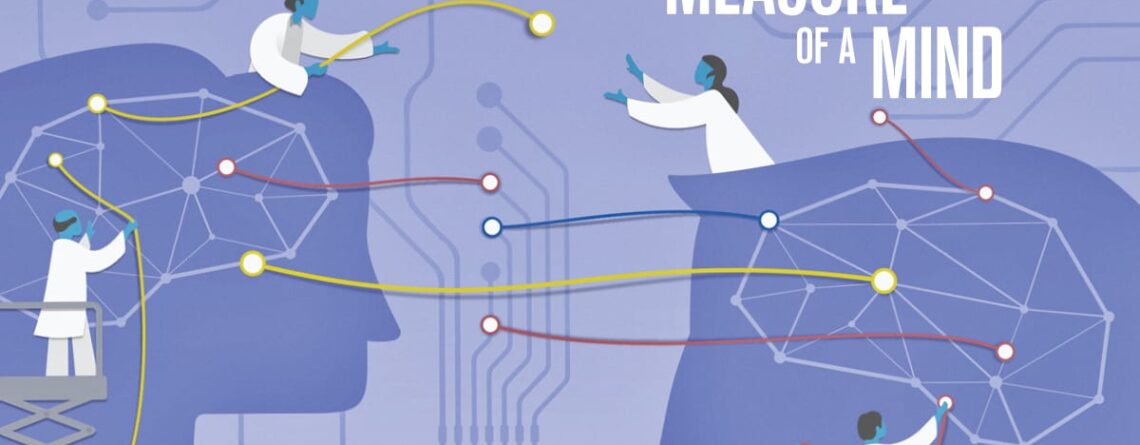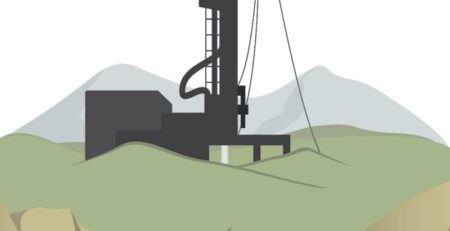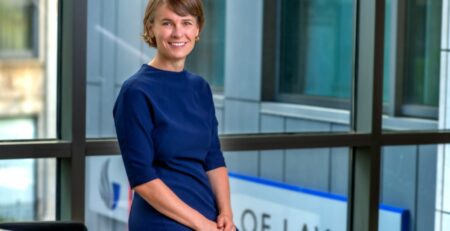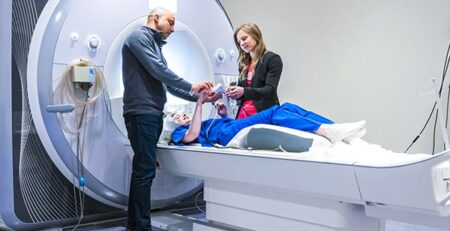written by Bonnie Rochman
written by Bonnie Rochman

Mental health is perceived as a touchy-feely discipline. Practitioners – psychiatrists and psychologists, among others — are interested in how people feel, think, behave. In a world in which data are used to evaluate nearly everything, mental health has seemed a category apart. How could you possibly use data science to evaluate the complex machinery that makes up a person’s mind?
Vince Calhoun, one of the world’s experts in brain imaging and analysis, has been pondering this question for a while. As an undergraduate in electrical engineering, he was intrigued by how engineering principles can be used to model the human body – blood flow, for example. That led him to pursue bioengineering in graduate school. At Johns Hopkins University, he connected with a psychiatry group doing neuroimaging.
“I was the only engineer,” says Calhoun, founding director of Georgia State’s new Center for Translational Research in Neuroimaging and Data Science (TReNDS), which is working to use big data and artificial intelligence (AI) to change the way we think about mental health disorders. “The joke was that I was the engineer analyzing the psychiatrists.”
It was no joke. Calhoun, a Distinguished University Professor of Psychology at Georgia State, realized technology has the potential to address “lots of the hard questions” psychiatrists were asking. At TReNDS, a collaboration among Georgia State, the Georgia Institute of Technology and Emory University, he’s searching for answers, using the center’s resources to delve into identifying biomarkers associated with brain health and disease.
“We’re working on really leveraging the synergy between all these institutions,” says Calhoun, who was recruited from the Mind Research Network in New Mexico, where he was president until Georgia State lured him to Atlanta last year.
Calhoun’s work centers on applying AI and data-driven analysis to brain imaging data, employing algorithms he’s developed to yield a more nuanced understanding of the brain and how it functions, as well as how it’s affected by mental or neurological illness. To do this, he creates neuroinformatics tools that help researchers make sense of increasingly large data sets. Calhoun’s tools are designed to assist scientists as they collect, manage, analyze and share data.
If Calhoun had his way, brain scans would be a standard part of medical care.
“If I could, I would get a brain scan early on everyone and then throughout their lives,” he says. “It would be a real treasure trove of data because by the time someone is sick, it’s often too late to help or understand how the problem developed.”
For starters, mental illness can be trickier to pin down than physical illness. It’s shaped by genetic and environmental factors, stress among them. While there are all sorts of biomarkers for identifying physical illness — blood tests for diabetes, X-rays for broken bones, CT scans for cancer — detecting mental illness is more elusive. Calhoun and the team of scientists he’s assembling at TReNDS are helping reshape the mental health landscape by using AI to pull more data from brain imaging scans, creating a new picture of mental illness in the brain. Calhoun, a Georgia Research Alliance Eminent Scholar in Brain Health & Image Analysis, is developing algorithms to improve our understanding of how the brain functions, its structure and genomics, so that sophisticated math and computer science can be deployed to better understand people with mood and psychosis disorders.
Vince Calhoun, one of the world’s experts in brain imaging and analysis, has been pondering this question for a while. As an undergraduate in electrical engineering, he was intrigued by how engineering principles can be used to model the human body – blood flow, for example. That led him to pursue bioengineering in graduate school. At Johns Hopkins University, he connected with a psychiatry group doing neuroimaging.
“I was the only engineer,” says Calhoun, founding director of Georgia State’s new Center for Translational Research in Neuroimaging and Data Science (TReNDS), which is working to use big data and artificial intelligence (AI) to change the way we think about mental health disorders. “The joke was that I was the engineer analyzing the psychiatrists.”
It was no joke. Calhoun, a Distinguished University Professor of Psychology at Georgia State, realized technology has the potential to address “lots of the hard questions” psychiatrists were asking. At TReNDS, a collaboration among Georgia State, the Georgia Institute of Technology and Emory University, he’s searching for answers, using the center’s resources to delve into identifying biomarkers associated with brain health and disease.
“We’re working on really leveraging the synergy between all these institutions,” says Calhoun, who was recruited from the Mind Research Network in New Mexico, where he was president until Georgia State lured him to Atlanta last year.
Calhoun’s work centers on applying AI and data-driven analysis to brain imaging data, employing algorithms he’s developed to yield a more nuanced understanding of the brain and how it functions, as well as how it’s affected by mental or neurological illness. To do this, he creates neuroinformatics tools that help researchers make sense of increasingly large data sets. Calhoun’s tools are designed to assist scientists as they collect, manage, analyze and share data.
If Calhoun had his way, brain scans would be a standard part of medical care.
“If I could, I would get a brain scan early on everyone and then throughout their lives,” he says. “It would be a real treasure trove of data because by the time someone is sick, it’s often too late to help or understand how the problem developed.”
For starters, mental illness can be trickier to pin down than physical illness. It’s shaped by genetic and environmental factors, stress among them. While there are all sorts of biomarkers for identifying physical illness — blood tests for diabetes, X-rays for broken bones, CT scans for cancer — detecting mental illness is more elusive. Calhoun and the team of scientists he’s assembling at TReNDS are helping reshape the mental health landscape by using AI to pull more data from brain imaging scans, creating a new picture of mental illness in the brain. Calhoun, a Georgia Research Alliance Eminent Scholar in Brain Health & Image Analysis, is developing algorithms to improve our understanding of how the brain functions, its structure and genomics, so that sophisticated math and computer science can be deployed to better understand people with mood and psychosis disorders.
From left: Jean Liu, associate professor of computer science; Jessica Turner, professor of psychology and neuroscience; and Vince Calhoun, Distinguished University Professor of Psychology and founding director of the Center for Translational Research in Neuroimaging and Data Science (TReNDS).
From left: Jean Liu, associate professor of computer science; Jessica Turner, professor of psychology and neuroscience; and Vince Calhoun, Distinguished University Professor of Psychology and founding director of the Center for Translational Research in Neuroimaging and Data Science (TReNDS).
From left: Jean Liu, associate professor of computer science; Jessica Turner, professor of psychology and neuroscience; and Vince Calhoun, Distinguished University Professor of Psychology and founding director of the Center for Translational Research in Neuroimaging and Data Science (TReNDS).

From left: Jean Liu, associate professor of computer science; Jessica Turner, professor of psychology and neuroscience; and Vince Calhoun, Distinguished University Professor of Psychology and founding director of the Center for Translational Research in Neuroimaging and Data Science (TReNDS).
What if the brain is like a book written in a language we don’t yet understand? Calhoun is trying to decipher it, developing techniques to help doctors and scientists understand what’s written within. He specializes in weaving together information from multiple data sets — a technique calleddata fusion — to provide better insight into complex problems.
At three pounds and 86 billion neurons, the human brain is an engineering marvel, with neurons communicating with one another to form circuits and transfer information that governs walking and talking, sleeping and waking — and so much more. It’s the body’s command center, so when it malfunctions, it matters.
“One challenge is that the brain is the most complex organ in the human body,” Calhoun says. “We don’t fully understand how it works, but we know that mental health diagnoses are imperfect.”
Someone who has schizophrenia, for example, may share the same symptoms with someone who has bipolar disorder. Schizophrenia itself is a diagnosis by exclusion. You must rule out bipolar disorder, depression and mood disorders by asking a lot of questions about what an individual is experiencing.
“We don’t even know if we’re trying to treat an actual clearly defined disorder or a suite of symptoms,” says Calhoun. “The categories are not as precise as they should be. We’re trying to come up with benchmarks.”
Take twins: If your identical twin has schizophrenia, you have just a 50 percent chance of developing it, too. To make matters more complicated, mental illness is also polygenetic, hinging upon an intricate mix of genes and environment. Consider that one person’s experience with schizophrenia — or any mental health disorder, for that matter — can vary widely from another’s, and it becomes clear why it has been challenging to develop treatments for mental illness.
Calhoun also has a personal stake in trying to better understand how the brain functions. His father has Parkinson’s disease and bipolar disorder has been diagnosed in his family, albeit after the course of his research was established.
“It’s made me see why this work is important,” he says. “Mental illness really impacts everybody.”
Calhoun recently received nearly $4 million from the National Institutes of Health’s National Institute of Mental Health (NIMH) to develop new models that use brain imaging and genomic data to better predict mental health disorders. It’s critical work: About one in five Americans lives with a mental illness. In 2017, that was nearly 47 million people.
As part of the NIMH grant, Calhoun and his colleagues are comparing two approaches to diagnosis: the conventional approach that relies upon a checklist of symptoms to generate a diagnosis and one that analyzes brain data. It may sound simple, but it’s far from it. Calhoun is overlaying various types of brain imaging with genomic data, mixing them together mathematically using machine learning and AI to identify unique data sets that contain more useful information than imaging or genomic data can provide on its own.
“We are focused on leveraging many different kinds of data, which is unique,” Calhoun says. “We’re not just looking at does the wiring in your brain change or does the activity in your brain get stronger or weaker or does your genome look a certain way? We are trying to combine all that information together because no data set captures all the available information.”
Our goal is to look at the brain in a more holistic way,” he says. “We try to let the data speak and help us understand what is going on in inside.”



This approach can be applied to any number of mental illnesses and brain disorders, including depression, anxiety, schizophrenia and Alzheimer’s disease. Learning to determine which data correlate with which condition helps make doctors’ lives easier and helps patients end diagnostic odysseys, months or years spent searching for the right diagnosis.
One of Calhoun’s projects involves looking at a sample of children to see who, over time, will develop mental illness. The study is designed to track the normative development of children, but Calhoun, who always sees things a bit differently, is using the data to see if some of the children have higher scores for symptoms of depression or psychosis by the time they’re in their 20s.
“Then we go back five years earlier and say, given that data, can we design a predictor of a specific mental illness emerging?” Calhoun says.
He’s also using deep learning to filter out people who are unlikely to be responsive to a certain medication, saving them time and frustration, and developing machine learning models to predict cognitive decline — a hallmark of Alzheimer’s disease — from a younger age.
At Georgia State, Calhoun works closely with Jessica Turner, professor of psychology and neuroscience, on a number of projects, including a study that seeks to pin down the mechanisms underlying schizophrenia and bipolar disorder. Understanding the mechanisms behind these disorders is the first step to finding what Turner calls “druggable or treatable targets so that we can minimize suffering and maximize functionality.”
These disorders are messy,” Turner says. “They’re not hard and fast. Not all treatment works on everybody. We want to uncover why some people are responsive and some aren’t.”
As a cognitive neuroscientist, Turner is interested in what it means to be human. She attempts to answer that question by analyzing neuroimaging measurements and genetic variations.
“How can we measure a mind?” says Turner. “What in the brain can we measure that relates to what we can measure in behavior? You are not going to answer that with 10 people off the street. You need big data.”
In schizophrenia, hundreds, perhaps thousands, of changes in genes can make a person more or less susceptible. Establishing correlations between genetic changes and brain images of people with and without the condition can help determine who will break with reality and hear, see and think things that people without schizophrenia don’t experience.
“If we were going to look at one gene and one part of the brain at a time, we’d be here forever,” says Turner, who has a long collaborative history with Calhoun on a number of psychiatric imaging and genetics projects. “If I’m going to design a study, I have specific hypotheses about what is playing a role in schizophrenia that I collect data about. Then another researcher comes along and asks, what about something else, maybe the age of onset and childhood trauma? So, you end up collecting millions of data points because you don’t want to miss anything. Then you have to be able to discern what’s important and what’s not.”
That’s where Calhoun’s work comes in, developing algorithms that identify patterns in large data sets.
“The richness of this approach that we are taking at TReNDS is bringing in every piece of information that we can. It’s rare to get so many people together in one place who can do that,” says Turner.
 “How can we measure a mind? What in the brain can we measure that relates to what we can measure in behavior? You are not going to answer that with 10 people off the street. You need big data.”
“How can we measure a mind? What in the brain can we measure that relates to what we can measure in behavior? You are not going to answer that with 10 people off the street. You need big data.”
— Jessica Turner

 “How can we measure a mind? What in the brain can we measure that relates to what we can measure in behavior? You are not going to answer that with 10 people off the street. You need big data.”
“How can we measure a mind? What in the brain can we measure that relates to what we can measure in behavior? You are not going to answer that with 10 people off the street. You need big data.”
— Jessica Turner

Computer scientist Jean Liu is helping. Another recruit from the Mind Research Network, Liu specializes in imaging genetics, using AI to find links among brain abnormalities seen on imaging, genetic profiles and epigenetics — how environmental factors affect gene expression.
“We have very limited information right now about which genetic mutations lead to psychiatric disorders, and how,” says Liu, an associate professor of computer science.
She and Calhoun are trying to figure out how to predict which children with attention-deficit/hyperactivity disorder (ADHD) will outgrow their symptoms. Up to 10 percent of U.S. kids receive an ADHD diagnosis, but about half no longer experience the inability to focus and/or hyperactivity by the time they’re young adults. To predict which children will stabilize, Liu and Calhoun are comparing kids with ADHD to adults with the disorder to see if they share the same brain abnormalities. One particular brain region, the cerebellum and inferior frontal region (the bottom frontal region, right above the eyes), appears related to cognitive and attention deficits, so they are homing in on genetic mutations associated with brain development of this area.
“Do we have the power to predict whether symptoms will persist into adulthood?” says Liu. Finetuning treatment could hang in the balance; if providers can determine that the condition will be lifelong, it’s likely that treatment will differ from what’s recommended for ADHD that limits itself to childhood.
“Vince is helping remove the noise,” says Liu. “He’s cleaning up the data so we can analyze it.”
Calhoun has been on cleanup duty for a long time. Psychiatrist and researcher Godfrey Pearlson first met Calhoun when he was a senior research assistant in a psychiatry imaging center at Johns Hopkins that Pearlson directed. Pearlson was using functional MRI (fMRI), which measures brain activity, to try to probe what the brain was doing when a person drove drunk. Subjects would drive in realistic simulators inside a scanner, and Pearlson would watch how their brains reacted.
“Unlike a simple task like pressing a button when you see a stimulus, driving is incredibly complicated,” says Pearlson, now a professor of psychiatry and neuroscience at Yale University School of Medicine.
“Your brain lights up like a Christmas tree, and it’s impossible to tell which part of the brain circuits or regions are involved with the behavior.”
Enter Calhoun, who realized that independent component analysis (ICA) — a computational technique that helps separate a whole into parts — could be harnessed to parse which brain circuits were switching on and off. That helped researchers winnow down what they were looking at.
“It simplified and made the whole problem intelligible and subject to analysis,” says Pearlson, who has gone from Calhoun’s mentor to his peer. Researchers everywhere saw the usefulness of applying ICA to fMRI. It’s now one of the main methods of analysis.
Another scientist might have stopped there. But Calhoun took it a big step further, putting together a “toolbox,” or cheat sheet, for how to apply ICA to imaging, along with associated algorithms. His toolbox has been downloaded hundreds of thousands of times by scientists, says Pearlson.
“He’s done the scientific community a favor by distributing this as an open source software tool,” he says. “[The tools] are the sort of thing where people will say, ‘Yeah, that makes sense. I wish I’d thought of it.’”

Computer scientist Jean Liu is helping. Another recruit from the Mind Research Network, Liu specializes in imaging genetics, using AI to find links among brain abnormalities seen on imaging, genetic profiles and epigenetics — how environmental factors affect gene expression.
“We have very limited information right now about which genetic mutations lead to psychiatric disorders, and how,” says Liu, an associate professor of computer science.
She and Calhoun are trying to figure out how to predict which children with attention-deficit/hyperactivity disorder (ADHD) will outgrow their symptoms. Up to 10 percent of U.S. kids receive an ADHD diagnosis, but about half no longer experience the inability to focus and/or hyperactivity by the time they’re young adults. To predict which children will stabilize, Liu and Calhoun are comparing kids with ADHD to adults with the disorder to see if they share the same brain abnormalities. One particular brain region, the cerebellum and inferior frontal region (the bottom frontal region, right above the eyes), appears related to cognitive and attention deficits, so they are homing in on genetic mutations associated with brain development of this area.
“Do we have the power to predict whether symptoms will persist into adulthood?” says Liu. Finetuning treatment could hang in the balance; if providers can determine that the condition will be lifelong, it’s likely that treatment will differ from what’s recommended for ADHD that limits itself to childhood.
“Vince is helping remove the noise,” says Liu. “He’s cleaning up the data so we can analyze it.”
Calhoun has been on cleanup duty for a long time. Psychiatrist and researcher Godfrey Pearlson first met Calhoun when he was a senior research assistant in a psychiatry imaging center at Johns Hopkins that Pearlson directed. Pearlson was using functional MRI (fMRI), which measures brain activity, to try to probe what the brain was doing when a person drove drunk. Subjects would drive in realistic simulators inside a scanner, and Pearlson would watch how their brains reacted.
“Unlike a simple task like pressing a button when you see a stimulus, driving is incredibly complicated,” says Pearlson, now a professor of psychiatry and neuroscience at Yale University School of Medicine.
 “Your brain lights up like a Christmas tree, and it’s impossible to tell which part of the brain circuits or regions are involved with the behavior.”
“Your brain lights up like a Christmas tree, and it’s impossible to tell which part of the brain circuits or regions are involved with the behavior.”
Enter Calhoun, who realized that independent component analysis (ICA) — a computational technique that helps separate a whole into parts — could be harnessed to parse which brain circuits were switching on and off. That helped researchers winnow down what they were looking at.
“It simplified and made the whole problem intelligible and subject to analysis,” says Pearlson, who has gone from Calhoun’s mentor to his peer. Researchers everywhere saw the usefulness of applying ICA to fMRI. It’s now one of the main methods of analysis.
Another scientist might have stopped there. But Calhoun took it a big step further, putting together a “toolbox,” or cheat sheet, for how to apply ICA to imaging, along with associated algorithms. His toolbox has been downloaded hundreds of thousands of times by scientists, says Pearlson.
“He’s done the scientific community a favor by distributing this as an open source software tool,” he says. “[The tools] are the sort of thing where people will say, ‘Yeah, that makes sense. I wish I’d thought of it.’”
“Your brain lights up like a Christmas tree, and it’s impossible to tell which part of the brain circuits or regions are involved with the behavior.”
Enter Calhoun, who realized that independent component analysis (ICA) — a computational technique that helps separate a whole into parts — could be harnessed to parse which brain circuits were switching on and off. That helped researchers winnow down what they were looking at.
 “It simplified and made the whole problem intelligible and subject to analysis,” says Pearlson, who has gone from Calhoun’s mentor to his peer. Researchers everywhere saw the usefulness of applying ICA to fMRI. It’s now one of the main methods of analysis.
“It simplified and made the whole problem intelligible and subject to analysis,” says Pearlson, who has gone from Calhoun’s mentor to his peer. Researchers everywhere saw the usefulness of applying ICA to fMRI. It’s now one of the main methods of analysis.
Another scientist might have stopped there. But Calhoun took it a big step further, putting together a “toolbox,” or cheat sheet, for how to apply ICA to imaging, along with associated algorithms. His toolbox has been downloaded hundreds of thousands of times by scientists, says Pearlson.
“He’s done the scientific community a favor by distributing this as an open source software tool,” he says. “[The tools] are the sort of thing where people will say, ‘Yeah, that makes sense. I wish I’d thought of it.’”
“It simplified and made the whole problem intelligible and subject to analysis,” says Pearlson, who has gone from Calhoun’s mentor to his peer. Researchers everywhere saw the usefulness of applying ICA to fMRI. It’s now one of the main methods of analysis.
 Another scientist might have stopped there. But Calhoun took it a big step further, putting together a “toolbox,” or cheat sheet, for how to apply ICA to imaging, along with associated algorithms. His toolbox has been downloaded hundreds of thousands of times by scientists, says Pearlson.
Another scientist might have stopped there. But Calhoun took it a big step further, putting together a “toolbox,” or cheat sheet, for how to apply ICA to imaging, along with associated algorithms. His toolbox has been downloaded hundreds of thousands of times by scientists, says Pearlson.
“He’s done the scientific community a favor by distributing this as an open source software tool,” he says. “[The tools] are the sort of thing where people will say, ‘Yeah, that makes sense. I wish I’d thought of it.’”
“Your brain lights up like a Christmas tree, and it’s impossible to tell which part of the brain circuits or regions are involved with the behavior.”
Enter Calhoun, who realized that independent component analysis (ICA) — a computational technique that helps separate a whole into parts — could be harnessed to parse which brain circuits were switching on and off. That helped researchers winnow down what they were looking at.
“It simplified and made the whole problem intelligible and subject to analysis,” says Pearlson, who has gone from Calhoun’s mentor to his peer. Researchers everywhere saw the usefulness of applying ICA to fMRI. It’s now one of the main methods of analysis.
Another scientist might have stopped there. But Calhoun took it a big step further, putting together a “toolbox,” or cheat sheet, for how to apply ICA to imaging, along with associated algorithms. His toolbox has been downloaded hundreds of thousands of times by scientists, says Pearlson.
“He’s done the scientific community a favor by distributing this as an open source software tool,” he says. “[The tools] are the sort of thing where people will say, ‘Yeah, that makes sense. I wish I’d thought of it.’”

illustrations by Reid Schulz












Leave a Reply